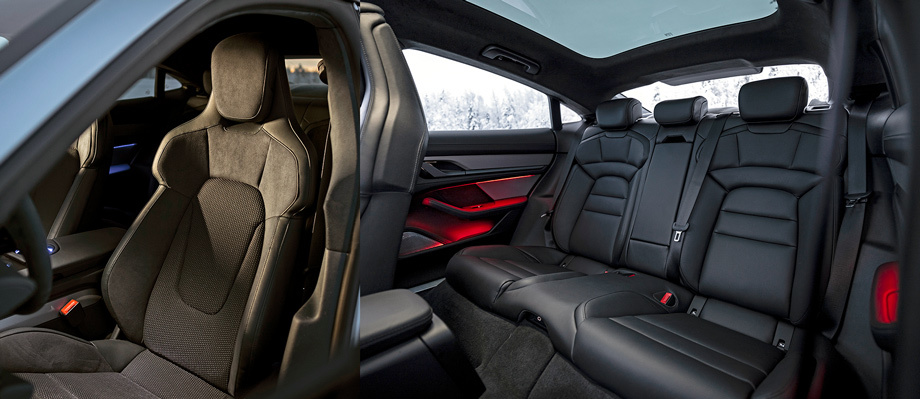The following is a continuation of the story about how the electric Porsche Taycan rides rather than an independent material. The conditions of winter Lapland are too specific. There are two types of roads: pure ice and pure snow, and the maximum speed on road signs is 50 mph. The Taycan 4S presented for the test was equipped with the same 800-volt 93 kWh battery as the Turbo and Turbo S tested by the boss ― but here, it is an option relative to the basic 79.2 kWh. Forecasters expect up to -10°C by morning. The cold is not extreme, but to maintain the experimental integrity, I ask to leave our car at the hotel not connected to charging: let it freeze.
Engineers claim that the Taycan is able to drive even in -50°C. But if the thermometer is below minus fifteen, it is strongly recommended to leave it connected to the power supply in the parking lot. The colder it is, the more energy is spent on heating up the battery. And at low temperatures, it will take some time after starting before the battery warms up to the extent to power the running motors. They say that a few minutes is enough. However, they still don’t give the opportunity to check: in the morning, they give the pre-warmed Taycan, removed from charging an hour before. “For logistical reasons.”

There is not a single page with an indication of power balance in the abundance of beautiful screens. How much will the power reserve decrease if you turn on, for example, heated seats or mirrors? I drive about 90 miles at a normal pace and in Normal mode, which automatically turns at every “restart”. When driving evenly at a speed of 50-55 mph, comparing the displayed data on the charge reserve and power reserve, I get the maximum possible mileage of around 180 miles. This is 20 percent less than the colleague got in the summer ― but this is a decent figure itself.
At the same time, it is warm in the cabin without any discounts. All heating and preheating devices are effective, matrix LED light elegantly illuminates the polar winter roads. The rear view camera washer is able to effectively remove snow from it. Even sliding door handles don’t scare: their lower edge protrudes above the door so that it is easy to pry it in case of freezing. Only the wipers in the absence of warm air from the engine compartment freeze more than usual ― and heating of the windshield is not offered. The switch to the economical Range mode is immediately noticeable: the light weakens, and the heater starts working in “waves”, saving calories.
An eight-kilowatt electric heater shouldn’t work at all on the pre-warmed car — a “heat pump”, that cools electric motors and inverters, transferring heat to the heater, is enough. In Normal mode, even the battery doesn’t warm up much, up to 5-10°С (40-50°F). It is another matter with Sport and Sport Plus, where, for the sake of greater returns, it is heated to 20-25°С (68-77°F), while stored energy is spent on it. Only in these programs, with the help of launch control, you can use the maximum available 530 horsepower (or 571 ― with a large battery) for 2.5 seconds. The rest of the time, there are 435 or, respectively, 490 available.
After half an hour of fast charging, the battery has 85% charge again, and ice tracks are waiting for me. The 20-inch wheels have non-studdable Goodyear UltraGrip Performance tires, modified to meet the Taycan’s need for low rolling resistance. Although these are hard tires of the “European” type, the grip on the ice is surprisingly good. It’s a pity they are noisy and not very comfortable ― on winter roads, the Taycan still shakes with a rigid body on small irregularities and pays attention to the wheel rumble, as it was in summer.

The fat plus of the Taycan relative to all the electric cars I remember is the ability to completely disable the stabilization system with an inconvenient touch button. The ice cover slightly cuts the comb of the electric car: in such conditions, any Porsche doesn’t roll and is controlled like that. Ice deprives it of the advantages of a low center of gravity, although a mass of more than two tons doesn’t seem to be a disadvantage ― on the contrary, working with weight redistribution helps at the entrances to turns. In Sport, the Taycan slides very clearly, and Sport Plus is more nervous and arrogant. The redistribution of traction to the front motor allows you to pull the car out of more than 90-degree drifts!
Alas, the electricity consumption is tripling: a full battery, according to my calculations, would be enough for 68 miles of “racing”. And the synthetic sound that can be output to the speakers in addition to the light natural “whistling” of electrical components is unlikely to please real petrolheads. Against the background of sports cars with internal combustion engines, the Taycan 4S now resembles a young prodigy who found himself in a gentlemen’s club. It seems that it knows everything and can do everything. But there is a lack of authenticity. Winter conditions only emphasize this.
This is a translation. You can read the original here: https://www.drive.ru/test-drive/porsche/5df378e3ec05c4c7180000ad.html

Published April 20, 2023 • 4m to read






